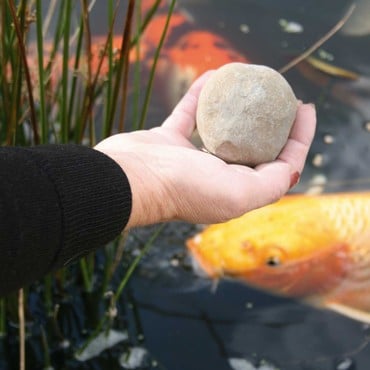Dirty Water!
I recently bought some water lilies that were sold specifically to be grown in containers. After a bit of a disastrous start I have had some success in that they seem to be growing and quite happy.
However as they are not in a pond the water has gone very green and I would like a suggestion on how to clear the water. Obviously there are no fish but the birds do tend to drink from the containers. I am not sure if your mud ball would be suitable or if you have any other suggestions?
Many thanks
Jennifer Taylor
Many thanks for your recent message concerning the best way to improve the water clarity in your pond. We have a number of pond care products which will all help improve the quality of the water but to make the best decision, we have to diagnose the problem.
The pond care treatments we supply fall into two distinct categories; mud and silt breakdown and weed prevention. Both will affect water clarity and we'll start with problems at the bottom of the pond...
First up are the EM Mud Balls you mention, a mix of Bokashi wheat bran, clay, EM microbes and EM ceramic powder, fused together to produce balls which promote sludge-eating microbial activity, leaving you with excellent water clarity. Fish also benefit from the addition of Mud Balls as the EM microbes help control ammonia levels and suppress any harmful pathogens in the water.
Also worth noting is the fact that if your pond is under 1000 litres in capacity, adding a mud ball will not produce any detrimental effects.
Performing a similar role is the Mud Muncher, also ideal when silt and sediment are muddying your waters. This liquid solution is pond wildlife-friendly and is added to the water to remove debris and break down mud, improving the quality of the water in the process.
However, if pondweed of some sort is causing the problems then you will need to look elsewhere. Barley Balls differ from the mud balls in the fact that the pre-treated barley straw floats on, or just under, the surface of the pond in a protective plastic case. The straw contains enzymes which help prevent the growth of algae and weed on the pond surface and these algal inhibitors are completely safe to use around fish and other forms of aquatic life – in fact, the manufacturers claim that the straw and ball can become home to beneficial pond insects which provide a source of food for fish.
Other key features to note are that the Barley Ball can be used in ponds under 1000 litres in size if an oxygenating feature is present (such as a fountain); that the optimum time to introduce the ball is between March and July; any weed present should be removed beforehand and that the results begin to appear after 3-4 weeks of the barley ball’s introduction. An important point is that mud balls and the barley ball can be used in the same pond at the same time.
From the same stable as the Barley Ball comes the Extract of Barley Straw liquid, a sure-fire blanketweed clean-up solution and if duckweed is the problem, then the Duckweed Control (again in liquid form) will help; both these treatment give excellent results if as such of the respective weed is removed from the pond with a net beforehand.
All the treatments listed above are perfectly safe to use around fish, aquatic plants, pets - and birds - so you need not worry about harming the birds which drink from your pond.
To surmise; the Mud Balls and Mud Muncher are better for general pond water clarity while the Barley Ball, Extract of Barley Straw and Duckweed Control will help keep the surface of the pond clear of weeds and slightly improve the water quality.
Hopefully this information is of help but if you'd like a second opinion, the aquatic section of the garden centre or fish dealer/pet store should be able to help. All the products I've listed are widely available so they shouldn't be a mystery!
Martin

























